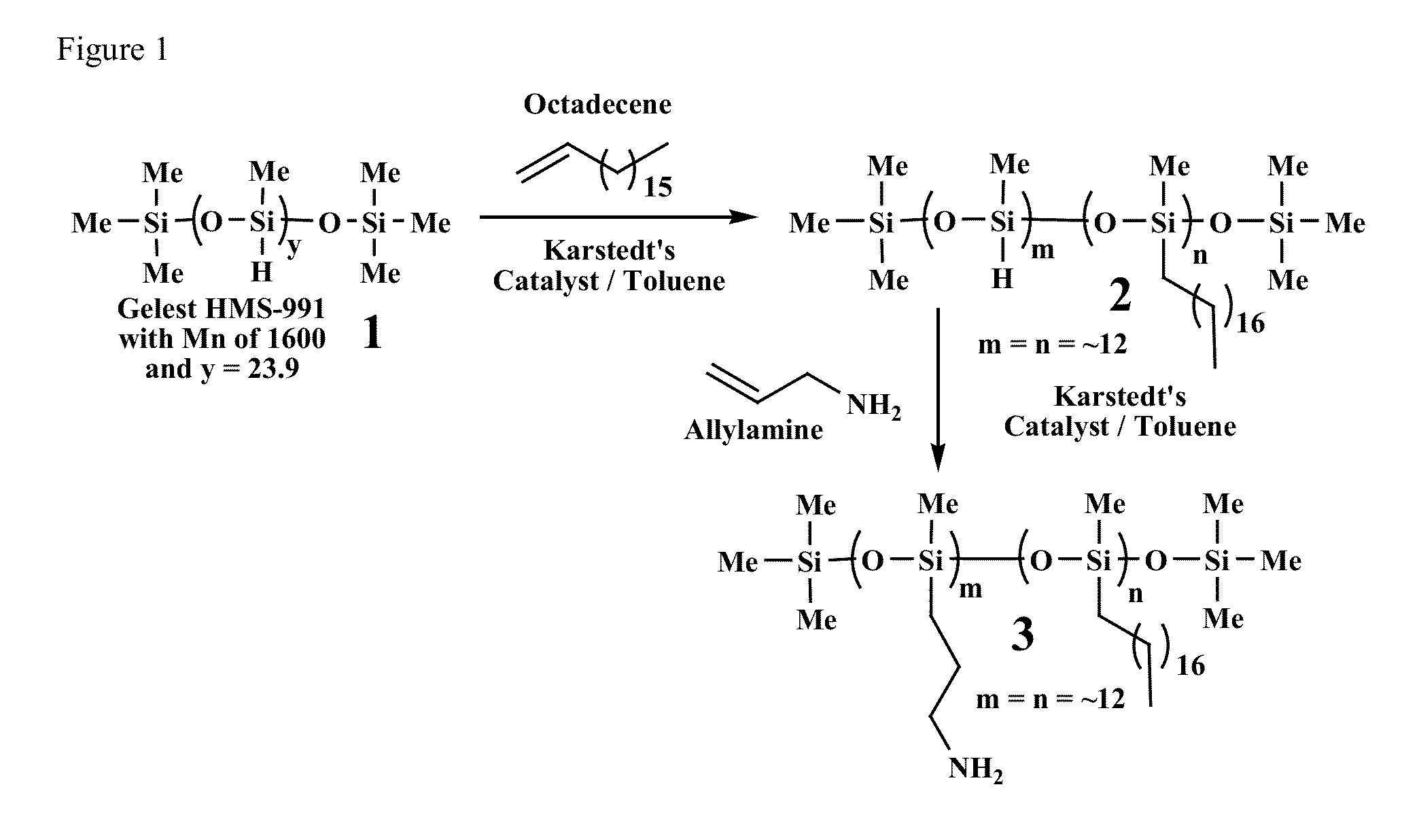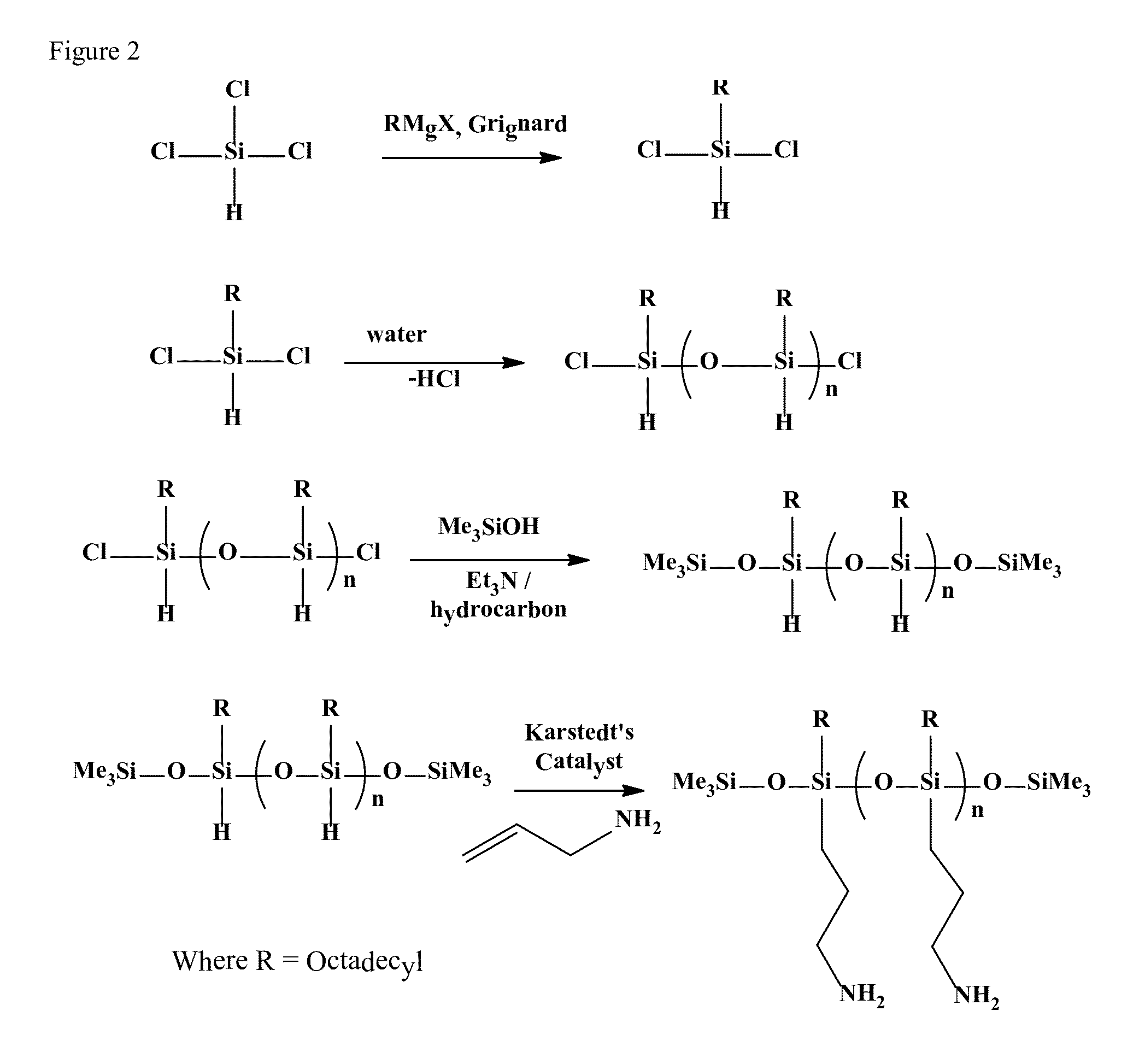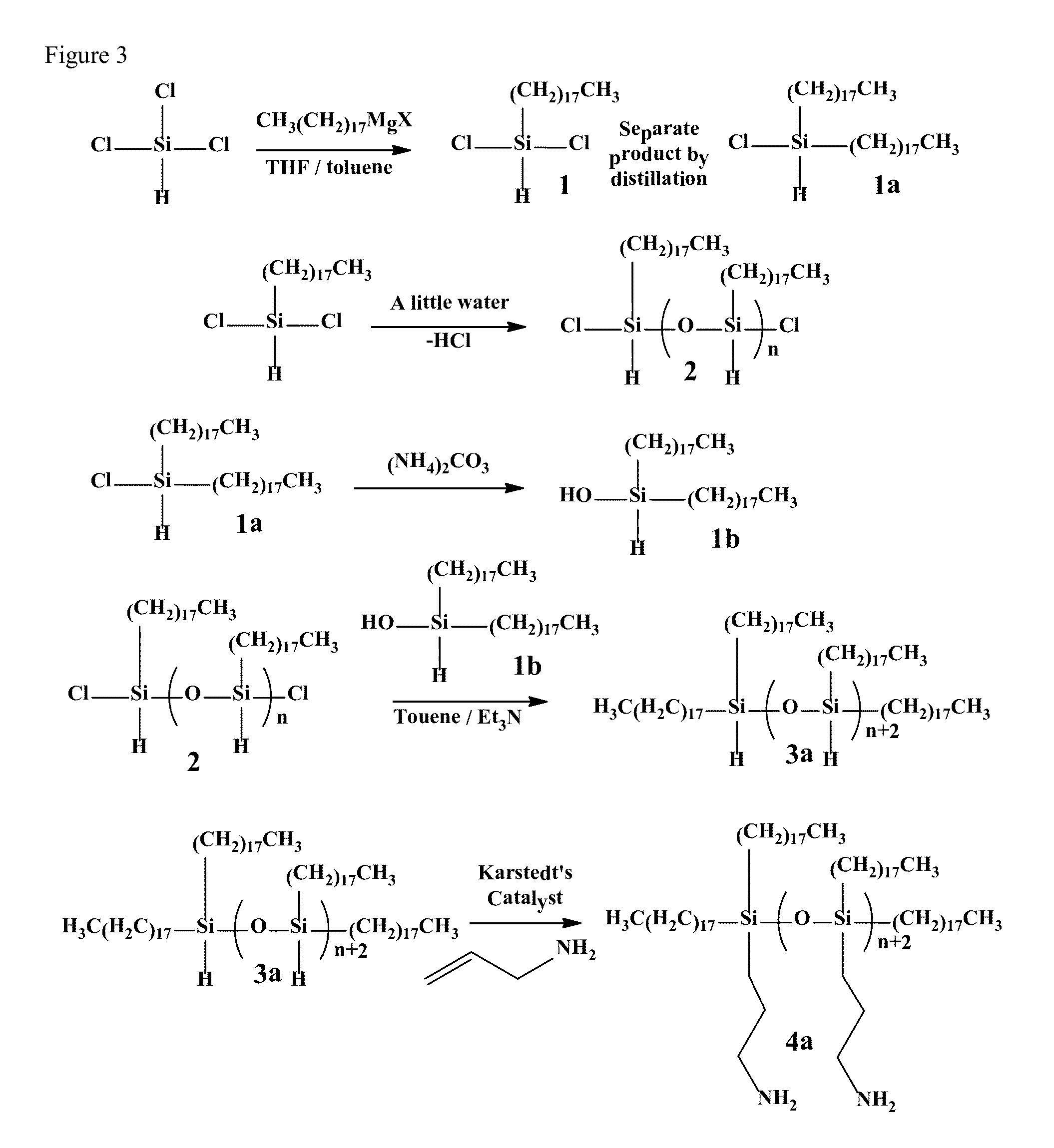Silicone ligands for stabilizing quantum dot films
a technology of quantum dots and ligands, which is applied in the direction of luminescent compositions, organic chemistry, chemistry apparatuses and processes, etc., can solve the problems of poor power efficiency, poor color rendering, and the number of critical shortfalls
- Summary
- Abstract
- Description
- Claims
- Application Information
AI Technical Summary
Problems solved by technology
Method used
Image
Examples
example 1
Preparation of Polymeric Silicone Amine Wax (PSAW-1:1)
[0145]This example provides a method for making polymeric silicone amine wax (PSAW) with a 1:1 ratio of alkyl amine (aminopropyl) to long-chain alkyl (octadecyl).
[0146]
[0147]The apparatus was set up with a 250 mL, 3-neck RBF equipped with nitrogen inlet adapter (Teflon valve / stopper), thermocouple positioned to measure reaction solution temperature directly (with temperature controller) and short path distillation head with receiver. Additionally the distillation head was attached to a bubbler containing a one-way valve. The apparatus was configured so that upon attachment of a Schlenk line to the hose adapter, nitrogen gas could be passed into the reaction flask, across the surface of the reaction solution and out the bubbler attached to the distillation head. Also, the one way valve on the bubbler allowed vacuum to be applied to the whole apparatus, from the bubbler to the hose adapter.
[0148]After attachment to the Schlenk line...
example 2
Preparation of Polymeric Silicone Amine Wax (PSAW-1:2)
[0155]This example provides a method for making polymeric silicone amine wax (PSAW) with a 1:2 ratio of alkyl amine (aminopropyl) to long-chain alkyl (octadecyl), using the procedure described above in Example 1. For example, silane polymer HMS-991 (10 g, 10.2 mL, 6.25 mmoles of polymer strands with 150 mmoles of silane) used 1-octadecene (25.3 g, 32.0 mL, 100 mmoles) and allylamine (11.4 g, 15.0 mL, 200 mmoles). Karstedt's catalyst was also scaled accordingly, using platinum for 20,000 turnovers in the first step (0.0050 mmoles) and then 1000 turnovers in the second step (0.050 mmoles). (302-071)
[0156]Analysis of Polymeric Silicone Amine Wax PSAW-1:2.
[0157]1H NMR (toluene-d8, δ): 0.2 to 0.5 (broad m, 90H, SiCH3), 0.6 to 1.0 (broad m, 96H, SiCH2CH2CH2NH2, SiCH2(CH2)16CH3), 1.1 to 1.7 (broad m, 528H, SiCH2CH2CH2NH2, SiCH2(CH2)16CH3), 2.5 to 2.8 (broad m, 16H, SiCH2CH2CH2NH2) 3.4 to 3.7 (broad m, 16H, SiCH2CH2CH2NH2). IR (cm−1, dia...
example 3
Preparation of Polymeric Silicone Amine Wax (PSAW-2:1)
[0158]This example provides a method for making polymeric silicone amine wax (PSAW) with a 2:1 ratio of alkyl amine (aminopropyl) to long-chain alkyl (octadecyl), using the procedure described above in Example 1. For example, silane polymer HMS-991 (10 g, 10.2 mL, 6.25 mmoles of polymer strands with 150 mmoles of silane) used 1-octadecene (12.6 g, 16.0 mL, 50 mmoles) and allylamine (22.8 g, 30.0 mL, 400 mmoles). Karstedt's catalyst was also scaled accordingly, using platinum for 20,000 turnovers in the first step (0.0025 mmoles) and then 1000 turnovers in the second step (0.10 mmoles). (302-075)
[0159]Analysis of Polymeric Silicone Amine Wax PSAW-2:1. 1H NMR (toluene-d8, δ): 0.2 to 0.6 (broad m, 90H, SiCH3), 0.6 to 1.0 (broad m, 72H, SiCH2CH2CH2NH2, SiCH2(CH2)16CH3), 1.0 to 1.8 (broad m, 288H, SiCH2CH2CH2NH2, SiCH2(CH2)16CH3), 2.5 to 2.9 (broad m, 32H, SiCH2CH2CH2NH2) 3.3 to 3.7 (broad m, 16H, SiCH2CH2CH2NH2). IR (cm−1, diamond): ...
PUM
 Login to View More
Login to View More Abstract
Description
Claims
Application Information
 Login to View More
Login to View More - R&D
- Intellectual Property
- Life Sciences
- Materials
- Tech Scout
- Unparalleled Data Quality
- Higher Quality Content
- 60% Fewer Hallucinations
Browse by: Latest US Patents, China's latest patents, Technical Efficacy Thesaurus, Application Domain, Technology Topic, Popular Technical Reports.
© 2025 PatSnap. All rights reserved.Legal|Privacy policy|Modern Slavery Act Transparency Statement|Sitemap|About US| Contact US: help@patsnap.com



